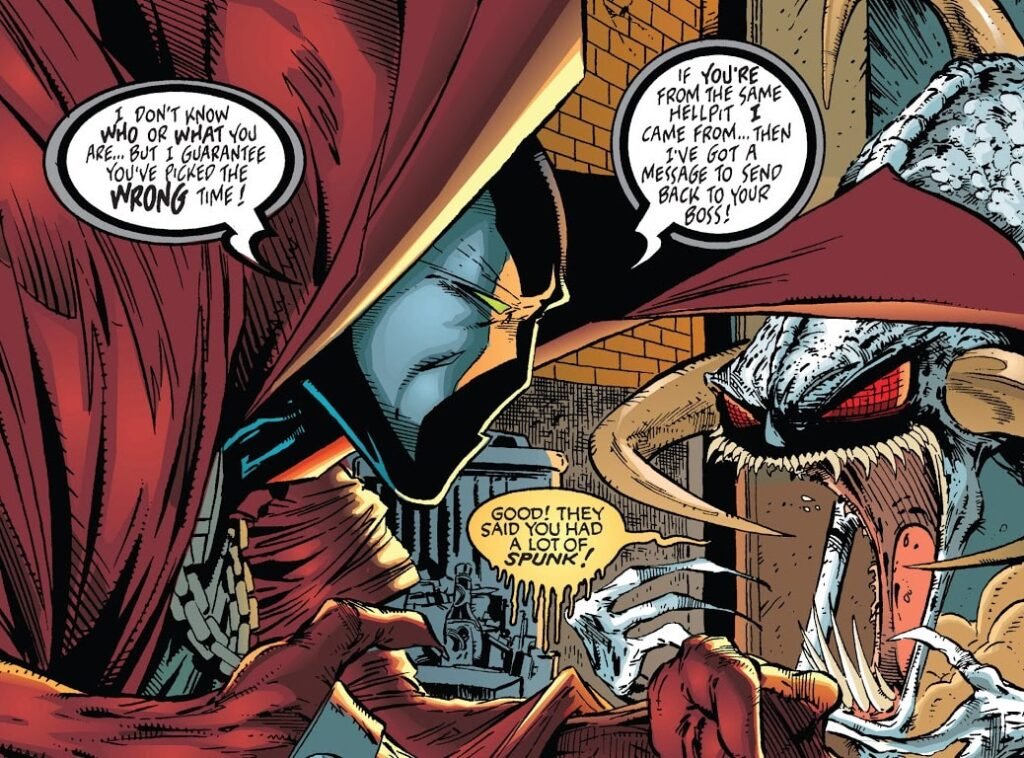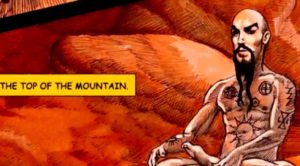
Spawn, a comic book title created by Todd McFarlane and published by Image Comics since 1992, features an American superhero character with an interesting pedigree. Spawn is distinguishable by “a “neural parasite cloak,” a particularly shaped face mask, green eyes and a red “M” on the chest”, as described by a judge in Wisconsin (and more on that below).
Spawn is a love story, of sorts, overlaid with tragedy and pathos. Al Simmons was a former soldier and CIA operative, betrayed by a colleague while on a mission to Botswana. Simmons was horribly burned to death. Sent to hell for his sins, Simmons was recruited as a member of a demonic army. Wanting to be reunited with his wife Wanda, Simmons made a pact with the army’s commander, Malebolgia. Simmons was released to Earth as a Hellspawn. Unfortunately, Simmons lost most of his memories upon his reincarnation five years after his death, and his animated corpse remained severely burned. Wanda had moved on and remarried, and had a daughter. A Hellspawn only appears on the Earth every few hundred years, and wields fantastic abilities powered by stuff called “necroplasm”. Once he runs out of necroplasm, Spawn will return to Hell, and so he uses his powers sparingly.

The story has evolved far beyond these initial parameters. Spawn has visited and dwelled in a variety of arcane locales, and, perhaps inevitably for a superhero comic book, there are presently several Spawns running about and interacting with each other.
Mr McFarlane initially made his fame with his dynamic visuals and meticulous detail on Marvel Comics’ Spider-Man. Readers were enamoured of his artistic style. The first issue of Spawn generated sales of 1.7 million copies. The concept has been translated into other media, and as a comic still sells very well. As Comic Book Resources noted in January 2022 https://www.cbr.com/todd-mcfarlanes-spawn-record-breaking-year/,
“August [2021] King Spawn #1 sold 497,000 copies, becoming the highest ordered superhero title from any publisher in the 21st century. The successful expansion of the Spawn line continued with October’s Gunslinger Spawn #1, moving 385,000 copies to become the bestselling monthly superhero comic book series launch in the past 25 years... The latest Spawn comic book launch, the team series The Scorched, written by Sean Lewis and illustrated by Stephen Segovia and Paulo Siqueira, has sold over 270,000 copies of its first issue.“
Spawn has not been without its real life controversies. The Supreme Court of Missouri was the forum of a case called Doe v. TCI Cable. Former NHL hockey player Tony Twist sued Mr McFarlane and others, claiming that the mafia don character Anthony “Tony Twist” Twistelli in Spawn was a misappropriation of his identity. The court found that Mr McFarlane had used the plaintiff’s name as a symbol of his identity and for commercial advantage. It also applied the legal lest of “predominant use” – was the use to exploit the commercial value of Mr Twistelli’s identity (even if there is some expressive content), or was it just to make an expressive comment about him? Unfortunately for Mr McFarlane, the predominant use of “Tony Twist” was found to be commercial exploitation. A jury made an initial award of $24 million in 2000, recalculated by a judge to $15 million in 2004. The verdict was upheld after two appeals in June 2006. Mr McFarlane’s company Todd McFarlane Productions then went into bankruptcy but was allowed to keep trading. In 2007, Twist and Mr McFarlane’s insurance companies settled the dispute for $5 million, according to the now defunct website the St Louis Post-Dispatch. It was an expensive miscalculation.

And it was concurrent with another piece of expensive litigation. In 2012, Mr McFarlane and fantasy writer Neil Gaiman settled a legal dispute over Mr Gaiman’s claim to entitlements to three characters which he created in an issue in which Mr Gaiman was guest writer: https://www.hollywoodreporter.com/business/business-news/spawn-comic-book-todd-mcfarlane-neil-gaiman-286071/ Mr McFarlane engaged Mr Gaiman to, as a court put it, “spice up the Spawn story line”. Mr Gaiman thought he would keep the rights to his creations, the popular Medieval Spawn, a curvy and cruel warrior angel called Angela, and a mentor called Cagliostro. “The Medieval (Gaiman) Spawn speaks as late twentieth century people expect a medieval character to speak and wears a knight’s costume. Plaintiff [Mr Gaiman] conceived of him as Sir John of York, a freelance knight born in England in 1146,” said a court in describing the Middle Ages version of Spawn.
Mr McFarlane disagreed as to who owned what. Proceedings commenced in 2002. There was talk of a deal at one stage: Mr McFarlane would hand over to Mr Gaiman proprietary rights to a classic British character called Miracleman, and Mr MacFarlane would gain all rights in the three characters created by Mr Gaiman. The deal fell over. Mr Gaiman won the proceedings, and the court found there was a joint copyright ownership (Mr Gaiman later sold all rights to Angela to Marvel Comics, who has been rejigged as the sister of Asgardian superhero Thor).

But Mr MacFarlane decided to dance around the judgment, and created three new characters called Dark Ages Spawn, Tiffany and Domina. Dark Ages Spawn was a replica of Medieval Spawn, and Tiffany and Domina were of the same cut as Angela. Mr Gaiman sued again, offering thanks, laconically, in his 2003 authorial introduction to Marvel Comics’ title 1602, “And, of course, to Todd, for making it necessary” . This is presumably a reference to the need for legal fees to run the dispute, paid for by writing for Marvel. The court frowned upon Mr McFarlane’s actions:
Much as defendant tries to distinguish the two knight Hellspawn, he never explains
why, of all the universe of possible Hellspawn incarnations, he introduced two knights from
the same century. Not only does this break the Hellspawn “rule” that Malebolgia never
returns a Hellspawns to Earth more than once every 400 years (or possibly every 100 years,
as suggested in Spawn, No. 9, exh. #1, at 4), it suggests that what defendant really wanted to
do was exploit the possibilities of the knight introduced in issue no. 9.

The idea of a Hellspawn appearing in different epochs is thoroughly intriguing (although not unique: see for example DC Comics’ Green Lantern and Image Comics’ Witchblade, which each feature characters wielding the same super-powered artefact at various points in history). This has lead more recently to the creation of “Gunslinger Spawn”, a Hellspawn with a tall Puritanesque black hat and six shooters, and which appeared most recently in the popular series, Scorched. In the dispute with Mr Gaiman, the judge decided to give Mr McFarlane some creative advice:
If defendant really wanted to differentiate the new Hellspawn, why not make him a
Portuguese explorer in the 16th century; an officer of the Royal Navy in the 18th century, an
idealistic recruit of Simon Bolivar in the 19th century, a companion of Odysseus on his
voyages, a Roman gladiator, a younger brother of Emperor Nakamikado in the early 18th
century, a Spanish conquistador, an aristocrat in the Qing dynasty, an American Indian
warrior or a member of the court of Queen Elizabeth I?

Mr McFarlane has guided Spawn through the highs and lows of various realities and challenges. By reason of Mr McFarlane’s control over the character, he is in the enviable and almost unique position of bringing the story to a close. American superhero comics rarely end, it seems. The temptation to bring characters back from the dead is too great for the publishers, even when their mortal remains are scattered as ashes across Russia (Marvel Comics’ Colossus), buried with a DNA test confirming their identity (DC Comics’ Batman), reduced by an anti-matter cannon to a pile of smoking cinders and bones (DC Comics’ The Flash), or shot in the chest by a sniper (Marvel Comics’ Captain America). Each publisher does not wish to permanently dispose of a commercial asset which might drive sales. But by reason of his absolute creative control, Mr McFarlane has no such limitations upon, eventually, closing the circle with his artistic creation.
In an interview with Forbes magazine in April 2020 https://www.forbes.com/sites/robsalkowitz/2020/04/08/we-cant-just-sit-here-and-do-nothing-todd-mcfarlanes-urgent-advice-to-the-comics-industry/?sh=7c11e63499d2, Mr McFarlane said:
“I’m going to my grave with Spawn! I know some people run their course with certain ideas – those are creative decisions. I’ve got almost 30 years of that character. I don’t feel tired in the least. And it’s one area of the business where I have control. I don’t have to ask anyone’s permission, I don’t have to deal with outside influences. It’s my haven when I start questioning the sanity of my fellow humans, I can just go and do my own thing with my own character. “
Mr MacFarlane is a man with a formidable amount of energy. But sooner or later, will he be happy to just sit on a beach with a tall cocktail in hand, and watch the boats? The truly interesting thing to watch in Al Simmon’s extended tale will be whether Spawn reaches a conclusion, or whether upon retirement Mr McFarlane decides to sell the character.

Happy 30th birthday, Spawn.

